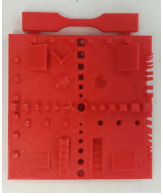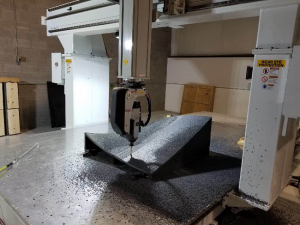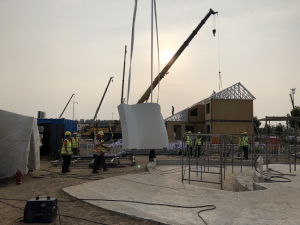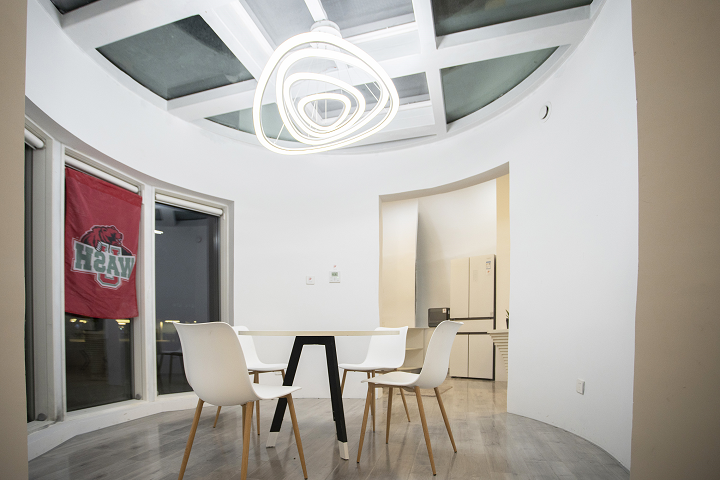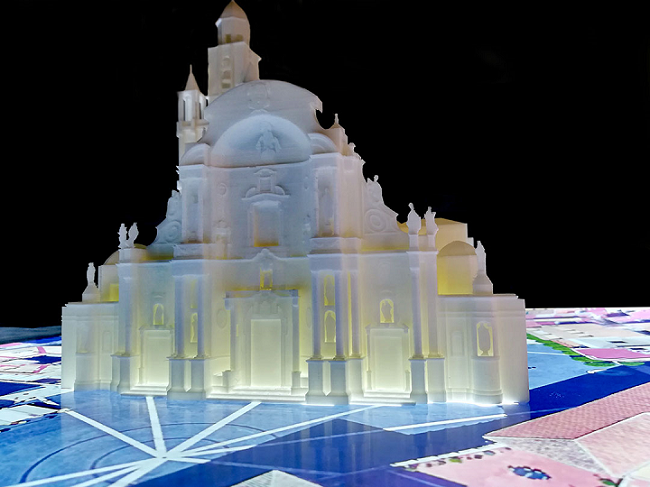Research Tests 3D Printed Electronic Components for Space Flight
In a three-year experiment, the COSMIAC Research Center at the University of New Mexico has been researching and testing electronics that have been embedded into 3D printed systems. With funding of $450,000, the research team completed three goals: to design and print simple prototypes with hybrid materials, embedded chips and wiring; to test the designed circuits using COSMIAC’s in-house testing capabilities; and to publish the results for dissemination.
 The team 3D printed, among other things, a circuit board with embedded electronics and subjected it to several experiments, which you can read about in a paper entitled “Environment Testing 3D Electronics Research Program.” The goal of the project was to 3D print a wide variety of different materials and test them in space conditions to determine changes in mass, along with other factors that would help determine which parts have the most potential to survive flight in the future.
The team 3D printed, among other things, a circuit board with embedded electronics and subjected it to several experiments, which you can read about in a paper entitled “Environment Testing 3D Electronics Research Program.” The goal of the project was to 3D print a wide variety of different materials and test them in space conditions to determine changes in mass, along with other factors that would help determine which parts have the most potential to survive flight in the future.
“An example of this type of experiment could be a soldier’s helmet where the electronics that monitor health and location are embedded into the material from which the helmet is created,” the researchers state. “The designer could reduce or eliminate much of the traditional spider web of wiring. In traditional satellite design, if any of the wires are crimped or broken, the satellite is rendered inoperative. There is no redundancy in flight. A much more reliable solution would be a satellite where all the wiring is embedded into the structural walls where it cannot be accessed or damaged. It should be possible to plug in the modules to an embedded backplane.”
Experiments were developed to measure the 3D printed objects’ electromagnetic properties among other factors. Three different 3D printers were used: a MakerBot, a Stratasys uPrint, and a 3D Systems ProJet 3500 3D printer. To test the various 3D printers’ capabilities, a CubeSat with entirely 3D printed components was produced.
“This process was an excellent opportunity for the students to see how to print a satellite body and then be able to use the components for performing fit checks on the modules and their associated hole and thread spacing,” the researchers continue. “The satellite shown was then used to make measurements for determining how long to make cables for the real satellite.”
Printed circuit boards were 3D printed from 16 different materials and subject to multiple tests. The FDM materials showed a great deal of moisture change where the SLA 3D printed items didn’t, making them more ideal for space applications.
“The team achieved the original objectives as well as going into other areas of investigation that were of interest to the space community as more and more spacecraft activities are looking to use 3D printing for satellite development,” the researchers state. “The outcome is that excellent advances have been made in the areas of 3D printing for space but that the ability to print space qualified and repeatable systems for future nanosatellite applications is still probably a decade in the future.”
In conclusion, the researchers indicate that 3D printing is not quite ready for use in government missions for actual flight. It has great benefit for prototyping, however, and in the future it may play a much larger role in the actual fabrication of spaceflight components.
Discuss this and other 3D printing topics at 3DPrintBoard.com or share your thoughts below.
Student Competition Team Uses 3D Printing and Design to Build Elements and Furniture for Lotus House
We have plenty of evidence to support the fact that 3D printing is definitely in the running to change the way we construct houses and other structures. For the last eight months, a group of students from Washington University in St. Louis, with support from the university’s International Center for Energy, Environment and Sustainability (InCEES), have been hard at work building the elements for Lotus House – an energy-efficient housing prototype that will compete in the upcoming Solar Decathlon China 2018.
Of course, Team WashU, consisting of students from both the School of Engineering & Applied Science and the Sam Fox School of Design & Visual Arts, is relying on 3D printing to design and fabricate these housing elements for the single-story, 650 square-foot Lotus House. The circular structure is fascinating, made of overlapping curved panels that are set around a main, central axis – just like a lotus flower that’s blossoming.
“We were inspired by the beauty, delicacy and cultural importance of the lotus,” said Lotus House Project Manager Kinga Pabjan, a master’s candidate in architecture and construction management. “But we didn’t start with the lotus. Our initial intention was to use emerging technologies, particularly additive manufacturing, to create organic form. We wanted to challenge the possibilities of 3D printing.
“We also wanted to create an open environment that allows for natural human circulation and promotes healthy feng shui. The floor plan suggests the cycle of daily living: coming home, preparing food, relaxing with others, readying for bed. Curved sliding doors enable occupants to maximize flexibility and change the spatial flow.”
Pabjan said that the Lotus House is the only non-orthogonal design in the Solar Decathlon China, as circular buildings can reduce the amount of wasted space in houses.
While most of the competition projects can take years to complete, Team WashU finished Lotus House in only eight months. The students had prior experience with design-build competitions, having two years preparing and constructing the solar-powered, concrete CRETE House for the 2017 US Solar Decathlon.
“For Solar Decathlon China, we met twice a week, and more frequently near the end of the spring semester, when we were 3D printing furniture and wall samples,” Pabjan explained.
“Each student focused on a given task: landscape, furniture, interior, structure, etc. We typically worked in pairs, then brought what we produced to the group. Everyone would gather around a large table, with (faculty adviser) Hongxi Yin, to discuss and design together.
“Then, the team had to figure out how to turn that design into reality.”
While still in the US, Team WashU partnered up with Additive Engineering Solutions (AES), headquartered in Akron, Ohio, to 3D print a sample wall framework and some furniture pieces, such as a small side table. Then, once the team arrived in China, the students spent over a month working with Beilida to make the roof and the walls for Lotus House, in addition to finalizing things like the electrical systems, floors, HVAC, and insulation, before starting construction last month.
When asked what inspired Team WashU to 3D print custom frameworks to use as molds for the house’s concrete side panels, Pabjan answered:
“The sustainability benefits. A typical wooden formwork can only be reused two or three times before it’s tossed into a landfill. The initial price of a 3D-printed mold is higher, but it can be reused a hundred times. 3D-printed formworks also create far less waste, use a fraction of the energy and save time, since fabrication can begin as soon as the digital description is created.
“And the design possibilities are practically unlimited! 3D-printed molds eliminate traditional manufacturing-process restrictions. Our exterior roof and wall panels have a unique parabolic design that carries organically to the interior. The panels fit together like overlapping petals.”
 Pabjan says the team learned a lot while working on the project, as many architects “may not fully understand how a building is fabricated” because they aren’t often on the actual construction sites.
Pabjan says the team learned a lot while working on the project, as many architects “may not fully understand how a building is fabricated” because they aren’t often on the actual construction sites.
“So to have this hands-on experience was extremely rewarding,” Pabjan said.
“At this stage in our careers, to be managing actual projects and construction jobs is just invaluable.”
The student members of the WashU team are very proud at how the Lotus House, with its 3D printed elements, turned out in the end.
“Lotus House is extremely ambitious in terms of the technologies used, the complexity of the form and the tight timeline,” Pabjan explained. “We also were trying to push the boundaries of what people are willing to do at Solar Decathlon. And after installing the first wall panel, we knew that it was going to be a success.
“As 3D printing becomes more affordable to the construction industry, I think we’ll see a lot more organic designs produced.”
Discuss this story and other 3D printing topics at 3DPrintBoard.com or share your thoughts in the Facebook comments below.
[Images: Team WashU]
3D Platform pits large scale 3D printing against traditional manufacturing
Transparent 3D printable nanostructures can mimic natural colors
Stratasys Releases Dedicated Chopped Carbon Fiber Polyamide 3D Printer Fortus 380mc Carbon Fiber Edition
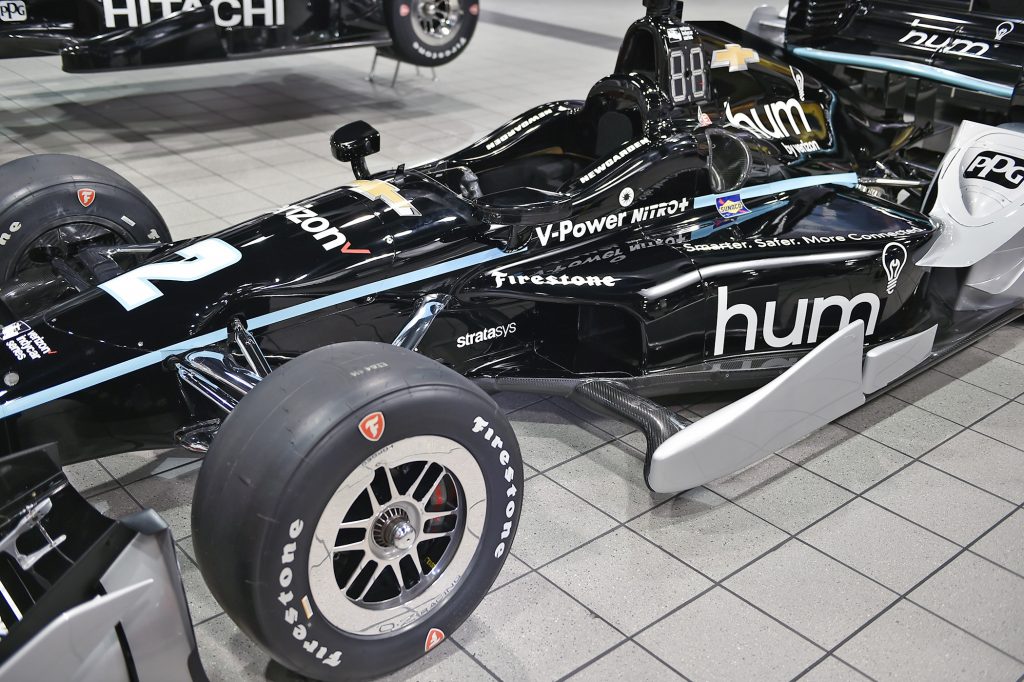
Stratasys/Team Penske Copyright: Scott R LePage
Stratasys today is launching a 3D printer specifically intended for carbon-fiber-filled Nylon 12. The Fortus 380mc Carbon Fiber Edition which we wrote about before will cost $70,000 in the US and is on sale now. Stratasys has offered carbon fiber 3D printing for a number of years now but only on systems priced above $200,000.
Stratasys Senior Vice President of Sales, Pat Carey says of the move,
“They’ve told us they want an affordable solution but in a reliable, industrial-quality system. So we’re now offering a more accessible system that’s based on our Fortus 380mc platform. Because the 380mc CFE is dedicated only to carbon-fiber-filled Nylon 12 and one other material, we’re able to currently offer it at the lowest price for any of our industrial printers.”
Stratasys describes the applications of the material as
“Stratasys expects the quickest adopters of its Fortus 380 CFE 3D Printer to be those making tooling and fixtures and those in industries that include Automotive; Recreational Sporting Equipment; Marine; Orthosis and Prosthesis; Defense; Aerospace; Medical Equipment; Oil and Gas.Similar to a typical injection molded carbon fiber reinforced plastic part, Stratasys Nylon 12CF is 35 percent chopped carbon fiber by weight, and it exhibits the highest stiffness-to-weight ratio of any FDM or FFF 3D printed part.”
“Stratasys Nylon 12CF is up to four times stronger than a competitively priced alternative in the X and Y axis, and it will maintain its mechanical properties at a 40 percent higher temperature. The Fortus 380mc CFE is between two and five times faster than the competitively priced carbon-fiber-based 3D printer.”
“Parts don’t exhibit appreciable warpage or shrinkage and will hold to
a tight tolerance. ““The Fortus 380 CFE builds parts in 0.010 in. (0.254 mm) layer thickness. The system is also compatible with ASA thermoplastic, for which is can build in either 0.010 or .005 in. (0.127 mm) layer thicknesses. The 3D printer’s build chamber measures 14 x 12 x 12 in. (355 x 305 x 305 mm). It offers water-soluble support material removal, which eliminates the need for manual labor to remove the supports.
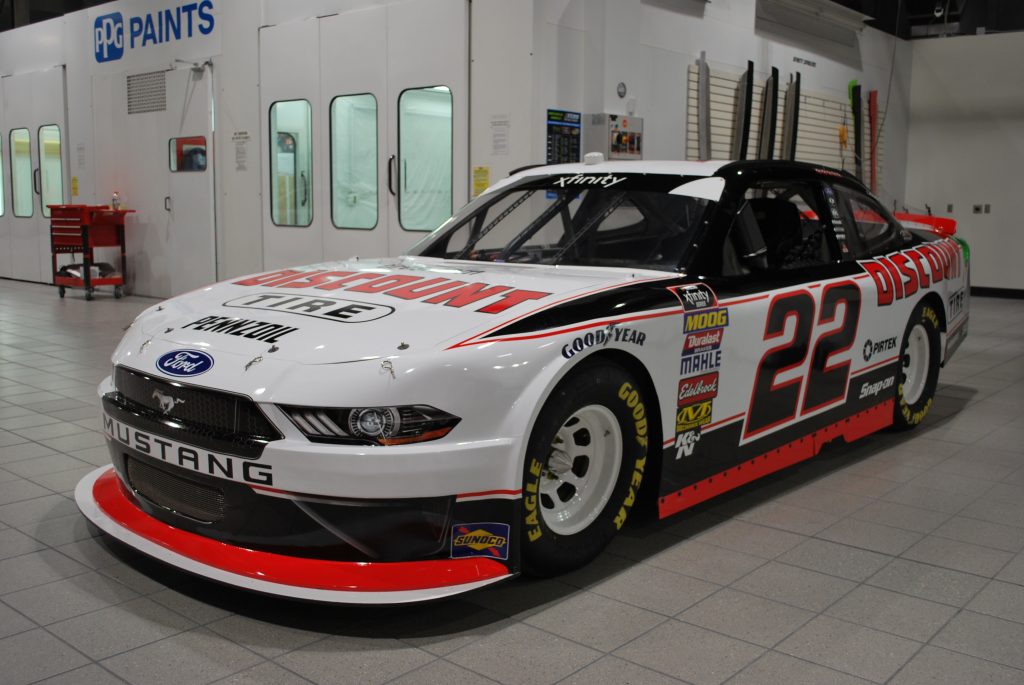
Terry Wohlers of Wohlers Associates says,
“For many years, the additive manufacturing industry has seen a need for a diversity of
machines that produce parts in high-strength composite materials, I’m hopeful the newest
machine from Stratasys will help to meet this need by offering strong parts in carbon fiber
and Nylon 12.”
IndyCar and NASCAR Examples
Team Penske, an IndyCar and NASCAR team makes prototypes and end-use parts from carbon-fiber-filled Nylon 12. Lightweight mirrors were made of the material and used in racing. Lightweight 3D printed mirrors is actually a tried and true application that has been tested and used across many racing series. It is also sometimes a bit of a crib since race teams feel comfortable talking about mirrors and their associated geometries. Meanwhile, they usually use the technology for other parts of the car that they are less open about discussing especially the more angelic teams. Racing itself is an exciting area, especially one for showcasing your products. It is also the gateway drug to the automotive industry. Upon reading the press release this was the first thought that came to mind along with, is this the Innovator’s Dilemma again as well as MarkForged must sure be doing well.

Stratasys/Team Penske
Monday 18 December 2017
Copyright: Scott R LePage
MarkForged
MarkForged has a continuous composite 3D printer that should produce strong parts but may tend to be more limited in design freedom. The company has pitched to the car industry from the beginning and is finding clients, growth and customers there. With Porsche on board as an investor, the erstwhile small company’s growth is vexing perhaps to Stratasys. Perhaps the firm is trying to toy with MarkForged’s inertia until its own High-Speed Sintering technology is ready for automotive? Stratasys is also a Desktop Metal investor and that company has sued MarkForged over patents related to metal printing, which MarkForged is also engaged with. Although this would be a tempting conclusion I think that there is much bigger game afoot.
Innovator’s Dilemma
Invented FDM as a technology and commercialized it, this is now used by over 500 or so startups worldwide clamoring for market share and growth. In the long run rather than one venture-backed firm I think that this hardscrabble open ecosystem is what could be a competitive threat to Stratasys. To place obstacles in between oneself’s profit centers and the oncoming hordes seems like a wise decision. The release of the competitively prices 123 systems from Stratasys and below this, the Makerbot printers are a testimony to this. Essentially I believe that Stratasys is trying to delay the competition by at several hereto noncontested price points place interesting propositions for companies willing to industrialize 3D printing for manufacturing. Bizarrely a few years ago there were barely any functional parts capable 3D printers between the price point of $2000 and $5000 and none between $20,000 and $100,000. So Stratasys is filling out its product line up in order to motivate companies to partner with it now for the long run. This is a crucial time in 3D printing because many firms are certifying parts, qualifying parts and going into production for the first time. There is also the Troop of Gorillas. These soft and gentle giants munch on leaf after leaf and just want to make the world a better place through plastics.
Polyamide
Polyamide is a huge market and a material that is used in many industrial applications. The Troop of Gorillas consists of a dozen or so chemicals and polymer companies each doing billions in revenue. A few of these, namely, Evonik, Arkema, DSM, Dow, BASF and Sabic have a lot of polyamide capacity and are active in investing in polyamide high-performance materials. These materials are subject to higher heat deflection, continuous service temperature and strength than existing materials. They also let these companies sell a reformulated version of existing capacity at an elevated price point. These companies would be more than happy to invest in significant revenue for the long term for their materials. PPA’s or high-performance polyamides will be a battleground in many applications in the years to come, a big win in volume for 3D printed automotive would be huge for each of these firms. Indeed, I still believe that BASF’s high interest in 3D printing stems mainly for it to be a source of next-generation PPA’s. So what application and industry will give us the biggest volumes the soonest?

Automotive
Impact, wear, stiffness and overall familiarity that components manufacturers have with the Polyamide (Nylon 12) material is driving adoption of this material in automotive. It has been used for a long time in prototyping and for small production runs. The material has been used in bridge manufacturing by companies such as CRP and the automotive companies have considerable expertise in it. Especially the divergent parts of the Volkswagen group and BWM. PPA’s are high performance enough to be used inside the engine bays, inside the cabin on exterior parts and throughout the supply chain in tooling, jigs, and fixtures. They’re more expensive than bulk and engineering plastics but often cheaper than ultra high-performance materials such as PEEK and PEI. They’re also far easier to use than those materials. So a new high-performance niche which is usable at volume is emerging. And the players in this niche have a fundamental choice between partnering up now to industrialize for the next decades. Its a game of musical chairs.

Fortus 380CF
Musical Chairs
And in the musical chairs game, there is a choice between the future performance of open systems and the current performance of Stratasys systems. Closed Stratasys systems that do not permit you to use any outside materials are more reliable with higher repeatability at this point. Open systems have lower reliability but much lower costs. This machine introduction, therefore, seems aimed squarely at introducing 3D printing in manufacturing for automotive. This is a system that universities can afford so that they can do research on these carbon fiber materials. This system an alternative to high-temperature printers that are emerging around the same price point for PEEK and PEI. These systems will be cheaper to buy but the part cost will be higher than with carbon fiber filled polyamide. Stratasys is, therefore, positioning this as an alternative to MarkForged, high-temperature systems, existing powder bed fusion systems and the promise of open systems in the future. You know us, you trust us, here is something that you can buy today. Vis a vis powder bed fusion FDM has a clear advantage in large singular parts and flat parts while SLS may be better for many thousands of small parts (this is geometry and size dependent). I think that this is a smart move to position this now for production at a lower price point with more acceptible part costs for automotive. In the coming year or two, the game of musical chairs in automotive will be played with partners for materials and production found. And once the music stops, the game will be over.
More Realistic Models and Prototypes Built with Interactive Technologies such as 3D Printing and Virtual Reality
For visualization of prototypes and infrastructures, models are one of the key factors. A high quality model makes it possible to truly capture a virtual design, along with reducing the scale of the original to make it able to fit on a table, or even in the palm of your hand. Scale models can help designers gain a deeper understanding of all the elements that make up a structure or object, as well as how it works and if there are any flaws in its design.
But, as modern technologies like touchscreens, 3D printing, and video mapping continue to grow, models can now include newer, bolder elements that digitally transform them, making them easier to understand and visualize.
According to a translated quote in an article by TRSD, “It is no longer necessary to manually make all the elements that make up a model since with 3D printing and thanks to the digital models that are more common every day in any work (3D software, BIM models, etc.) we can reproduce in a simple way any element without resorting to complex manufacturing modes.”
For a long time now, traditional models have been meticulously created by hand, which means the model makers are truly closer to artists than simply manufacturers. But model making has continued to evolve over the years, thanks to these newer technologies, into what’s known as interactive models that users are able to…well, interact with more.
Interactive models, which simulate movement through the use of video projection or animations under transparent surfaces, have many advantages.
“They can be programmed with the desired animations or to reproduce real time processes,” I A Manufacturing wrote. “Use your AR/VR device to add movement to your model and a real-time simulation of the environment or the actions that you prefer. Display all the data that you desire in your models to increase your value.”
Models that incorporate these modern technologies are truly the future, and allow designers to expand the possibilities of model making. By adding augmented reality, which Foundry says is an overlay of content on the real world that’s not actually anchored to it, and virtual reality to models, companies like TRSD can give their clients a better understanding of what exactly their real projects will look like once completed. 3D printing gives incredible detail, and adding AR and VR make it possible to change or move objects around with simply the click of a button.
TRSD wrote, “Imagine for a moment that we can place our model on a touch screen that recognizes the elements that we are placing on it and that, depending on the type of object, the screen adapts the displayed image by changing everything around it, for example green areas, roads, services, etc.”
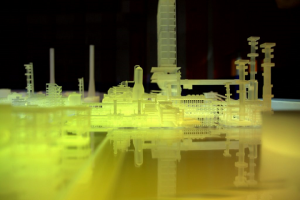 Many product designers, construction and real estate companies, and architecture and engineering studios are already using interactive models to give their customers more bang for their buck. Another real world example of interactive models is IKEA, which provides an accessible app that allows customers to see how their new furniture will fit in their homes and offices.
Many product designers, construction and real estate companies, and architecture and engineering studios are already using interactive models to give their customers more bang for their buck. Another real world example of interactive models is IKEA, which provides an accessible app that allows customers to see how their new furniture will fit in their homes and offices.
Incorporating additional interactive technologies, such as touchscreens and video mapping, brings us even closer to a new class of interactive models that can be personally adapted to each individual user, which will allow for better communication between manufacturers and clients.
By incorporating technologies like AR, 3D printing, and VR, companies can create models and prototypes that are more interactive and realistic than ever before, while also lowering costs by using digital files and less material, which also helps in reducing waste.
What do you think of this story? Discuss interactive models and other 3D printing topics at 3DPrintBoard.com, or share your thoughts in the Facebook comments below.
[Images: TRSD]
Alexis Walsh APEX SERIES Mixes Traditional Fashion With 3D Printing
3D printed fashion is providing designers with a range of tools they previously could’ve only dreamt of. With projects like on-demand, online fashion and fabric components, the fashion shows were bound to take notice. Enter Alexis Walsh and Justin Hattendorf, collaborating together to merge digital simulation, 3D printing and traditional craft. Walsh has long been experimenting with […]
The post Alexis Walsh APEX SERIES Mixes Traditional Fashion With 3D Printing appeared first on 3D Printing.
Ford files patent for brake disk 3D printing method
World’s Largest 3D Printed Coral Reef Now Resides in the Maldives
Coral reefs are important not only to the millions of species that live in them, but to humans as well. Reefs protect coastlines from storm surges during violent storms, and they also offer a great deal of income from tourism and fishing. Coral reefs are in quite a bit of trouble at the moment, though. 50 percent of the world’s reefs have died in the last 30 years, and 90 percent of the surviving reefs may die off in the next century if action isn’t taken to save them. The reefs are suffering from numerous threats – climate change, overfishing, damage from boats, and other human-caused damage.
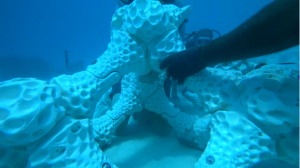 Humans may be responsible for threatening the coral reefs, but many humans are also taking responsibility for saving and restoring them. 3D printing has been found to be an effective way of creating artificial coral reefs, which are then dropped into the ocean where it’s hoped, free-floating coral polyps will attach themselves to them and grow into new coral structures. That coral will then attract the fish and other species that make their homes in reefs, and a new, natural reef will grow from the artificial seed material.
Humans may be responsible for threatening the coral reefs, but many humans are also taking responsibility for saving and restoring them. 3D printing has been found to be an effective way of creating artificial coral reefs, which are then dropped into the ocean where it’s hoped, free-floating coral polyps will attach themselves to them and grow into new coral structures. That coral will then attract the fish and other species that make their homes in reefs, and a new, natural reef will grow from the artificial seed material.
Several reefs have already been 3D printed and sunk into the ocean, and now Reef Design Lab, an Australian organization dedicated to the creation of artificial reefs, has created what, it turns out, is the largest 3D printed artificial coral reef so far. 3D molds of the reef structures were 3D printed over 24 hours, then used to cast the structures in ceramic, which is similar to the calcium carbonate found in actual coral reefs. The 3D printed molds were printed in Australia and shipped to the Maldives, filled with concrete, assembled at Summer Island and then dropped into the ocean, where they now rest seven meters below the surface.
Live coral was then transplanted into the artificial reef, where it will hopefully grow and colonize the artificial structure, forming a new, living reef.
“3D printing technology helps us to develop more innovative ways of protecting coral reefs. The technology allows us to mimic the complexity of natural reef structures, so we can design artificial reefs that closely resemble those found in nature,” said Alex Goad of Reef Design Lab. “We hope this will be a more effective way of growing and restoring corals.”
The creation of artificial reefs isn’t new – humans have utilized sunken ships and concrete blocks to attract coral in the past. 3D printing, however, allows for the natural structure of coral reefs to be imitated, which attracts more marine life. In this case, Goad used CAD to design replicas of naturally-occurring coral reef structures before 3D printing them. The complex shapes of natural reefs are difficult to create in any other way, so 3D printing has become a valuable asset in the creation of these reefs.
It will take several years for coral and the other species that make reefs their home to populate the artificial structures, so we won’t know for some time if these 3D printed experiments are truly working. They show a lot of promise, though, and for the 25% of marine species that depend on coral, help can’t come soon enough. Scientists are hoping that the Summer Island reef will be covered in coral within the next two years, and if the project succeeds, more will likely follow.
“Projects like the 3D printed reef are popular among guests, who like that we protect our environment,” said Mari Shareef, Manager of the nearby Summer Island Resort. “And it’s not only for the guests. Our staff, most of whom are Maldivian, want to protect their environment. “Ultimately, we want to help promote a culture of environmental stewardship, not just at Summer Island, but across the Maldives.”
Discuss this and other 3D printing topics at 3DPrintBoard.com or share your thoughts below.
[Source: Verdict/Images: Reef Design Lab]


